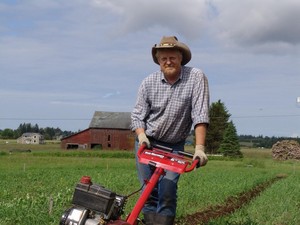27 Jan Tue 2009
Microcredit and CSA Programs
Muhammad Yunus received the Nobel prize in 2006 for his work in developing microcredit - tiny amounts of credit available for poor villagers (mostly women) in Bangladesh. This loan program has been embraced by many other countries around the world and has helped 500 million people. Obviously, a very good solution to one of the main problems in agriculture - capital to buy seeds, hire labor, buy equipment, and just to live until harvest. In this country, we have another version of microlending that I find VERY helpful - CSA share programs. As most everyone knows by now, Community Supported Agriculture (CSA) share programs pay the farmer upfront so he/she can buy seeds, hire labor, buy equipment, and just live until harvest. It requires the consumer to become a shareholder, in effect a partner, in the farm. I am in my third year of a CSA program and I actually got enough early money to buy seeds this year. Last week, I spoke with a banker and a developer and I asked them their perspectives on the looming credit crunch for mainstream farmers in the US. My fear is that, with the banks frozen and not lending, many farmers will not be able to plant. Then, the bankers and the government might wake up in July or August and realize there is not enough grain to go around. After that, it is anybody's guess what the response will be. When I asked about this scenario, both the banker and developer said that banks are lending, but simply enforcing more stringent credit standards. This assuaged my fears a little bit, but I still wonder about even a 5% dip in planting acreage. True, there was a 20% greater harvest in 2008 over 2007, but it is still worrisome. When Earl Butz, Nixon's Secretary of Agriculture, dropped target prices for grain and introduced the subsidy system, the federal government stopped lending farmers money and instead gave farmers a check. By convincing farmers to plant "fence row to fence row," he assured a glut in the market. Since the 70's, production has increased and prices have decreased. Last winters $15/bushel wheat was largely a speculative blip. So now we don't have a pool of fallow land in the soil bank, like in the 60's. What we have is constant upwards pressure on production, and a looming drop in production if farmers don't get capital. A recipe for disaster, as food availability is determined by a few ethically-challenged bankers. So, what to do? I suggest you run, not walk, to your nearest CSA farm and plunk down some money so the farmer can plant.

